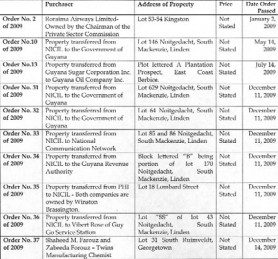Asserting Guyana’s international leadership role on climate change, the Minister announced that Guyana would push for legally binding outcomes at the United Nations Climate Change Conference in Mexico later this year, while the local Multi-Stakeholder Steering Committee would continue to oversee LCDS domestic initiatives. The Norway money, he said, would enable the financing of critical transformative infrastructure; Low Carbon Small Business Initiatives; the cost of Land demarcation and land titling for indigenous communities; and the work of the Office of Climate Change.
LCDS has a short but interesting history. Since 2005, civil society had questioned Guyana’s failure to participate in the international discussions on mitigation of, and adaptation to, climate change, despite being a high forest, low deforestation country. But it was not until the end of 2006, following the completion of the National Competitiveness Strategy, that President Jagdeo recognised the possibility of capturing funds suggested by UK’s Sir Nicholas Stern’s economic study of the costs of mitigating climate change. He became an instant convert, even offering to assign most of Guyana’s forests under an international protection regime, in exchange for money.
The President then considered, based on a study by McKinsey, consultants, two options – the first, logging and mining followed by forest clearance and replacement by agricultural plantation crops; and the other, foregoing this option in exchange for an annual annuity of US$580 million, computed on a remarkably optimistic 10 per cent annuity on the capitalised value of the exploitation and cropping.
This was soon put in the first draft of the Low Carbon Development Strategy (LCDS), at the centre of which was significantly reduced forestry activity, and a sketchy spending plan for some of the projects developed in the National Competitiveness Strategy. A road show followed in the form of an unprecedented series of single-message presentations on the draft LCDS by the President and Ministerial teams, sent out from the Office of Climate Change housed in the Office of the President. The information communicated was incomplete and numerous questions remain unanswered. That has led to the kind of confrontation between the gold miners and the Government over the mining sector’s perception that the Government was planning to give an effective veto over mining licences, to the Guyana Forestry Commission.
Norway has rejected the proposal by President Jagdeo from Guyana to channel funding through the Office of the President, and is negotiating for a multi-donor trust fund to handle the annual payments. The inclusion of the US$30M in the 2010 Budget is surprising and even premature since there are a number of matters addressed in the Guyana-Norway Memorandum of Understanding (MoU) and its accompanying Joint Concept Note, which are subject to further negotiations and agreement.
Norway has set no conditions on how the money should be spent, unlike the REDD Readiness Preparation grants being negotiated separately by the Guyana Forestry Commission (GFC) from the World Bank’s Forest Carbon Partnership Facility.
The REDD Readiness Preparation money is subject to spending plans agreed in principle by the Participants Committee of the FCPF, and to disbursement rules of the World Bank. Unlike the LCDS, and notwithstanding the absence of commitment from Guyana in its REDD Readiness Preparation Proposals, FCPF/REDD money is intended to plan for explicit reductions in emissions of forest carbon. In this sense, the absence of such requirements in the Norway-Guyana MoU is remarkably generous.
While the economic justifications for the development proposals on LCDS projects are set out in the National Competitiveness Strategy (NCS), they are reflected in outline only in the LCDS. Costings are not explained in the LCDS and no priorities have been suggested. A rational approach would be to take the NCS and LCDS as background documents and to revive the non-partisan independently-moderated multi-stakeholder forum which prepared the National Development Strategy in 1995-6. The Norwegian money might be used to co-fund some of the high-priority projects to be agreed through this forum.
The four items listed by the Minister to be funded or co-funded from the Norwegian payment in 2010 are all described in such vague terms that none has been through any rigorous analysis and evaluation. For example, his reference to “critical transformative infrastructure” can mean the fibre optic cables and technology park (US$10 – 30 million), the Amalia Falls Dam (US$ 400 -600 million), drainage, irrigation and road development (US$300 – 500 million), all of which are mentioned in the revised LCDS.
On the issue of land demarcation and land titling for indigenous communities, there are still some 40 Amerindian communities without title and demarcation, and no process for addressing security of tenure for communities which do not fit the eligibility criteria of the Amerindian Act 2006. In addition there is no provision for reviewing the contested titles from previous demarcations; for addressing the serious problem of expanding needs due to population increase; and that in indigenous areas, agriculture has a low level of productivity. This too needs to be addressed by stakeholders with the Government.
Finally, the Minister did not identify any sums allocated for mitigation activities – which comprise the fundamental basis of the REDD bargain.
Diverting Public Funds
We have discussed elsewhere the constitutional and statutory requirement that all funds belonging to the state should be placed in the Consolidated Fund. The table below shows how the Government has been misusing the provision of an old law, the Public Corporations Act, intended to facilitate the transfer of government-owned property to a corporatised entity.
 It now uses that provision to transfer assets which it proposes to sell or otherwise dispose of, to the National Industrial and Commercial Investments Limited (NICIL) and for NICIL to sell the property.
It now uses that provision to transfer assets which it proposes to sell or otherwise dispose of, to the National Industrial and Commercial Investments Limited (NICIL) and for NICIL to sell the property.
That was the case with the Duke Street property under Order 2 of 2009 and Order 37 of 2009, which have been the subject of public comments, because of the relationship between the owners of those businesses and the President. NICIL is chaired by the Minister of Finance and its members include the Head of the Presidential Secretariat, the Minister of Agriculture and Mr. Winston Brassington.
When NICIL sells any property, it retains the money to meet whatever expenses it considers appropriate, paying such sums as dividends as it considers appropriate. Meanwhile NICIL has failed to file annual returns and audited financial statements with the Registrar of Companies. The Constitution is subverted; the politicians control public moneys; and the public is kept in the dark.





